
Tibetan Buddhism is a form of Buddhism practiced in Tibet and Mongolia. It also has a sizable number of adherents in the areas surrounding the Himalayas, including the Indian regions of Ladakh, Sikkim, and Arunachal Pradesh, as well as Bhutan and Nepal. Smaller groups of practitioners can be found in Central Asia, Xinjiang, Inner Mongolia, and some regions of Russia, such as Tuva, Buryatia, and Kalmykia.
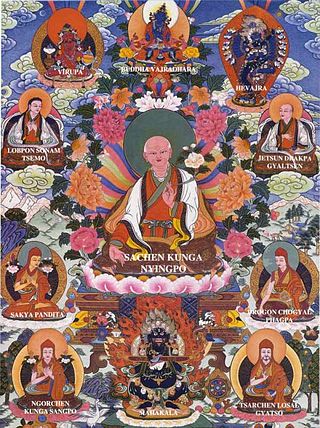
The Sakya school is one of four major schools of Tibetan Buddhism, the others being the Nyingma, Kagyu, and Gelug. It is one of the Red Hat Orders along with the Nyingma and Kagyu.

Mahāmudrā literally means "great seal" or "great imprint" and refers to the fact that "all phenomena inevitably are stamped by the fact of wisdom and emptiness inseparable". Mahāmudrā is a multivalent term of great importance in later Indian Buddhism and Tibetan Buddhism which "also occurs occasionally in Hindu and East Asian Buddhist esotericism."

The Jonang is a school of Indo-Tibetan Buddhism. Its origins in Tibet can be traced to the early 12th century master Yumo Mikyo Dorje. It became widely known through the work of the popular 14th century figure Dolpopa Sherab Gyaltsen. The Jonang school’s main practice is the Kālacakra tantra, and they are widely known for their defense of the philosophy known as shentong.
Ngawang Lobzang Jampel Tsultrim Gyatso or Tsultrim Gyatso was the 10th Dalai Lama of Tibet, and born in Chamdo. He was fully ordained in the Gelug school of Tibetan Buddhism, studied the sutras and tantras, had several students, and rebuilt the Potala Palace.

Nyingma, often referred to as Ngangyur, is the oldest of the four major schools of Tibetan Buddhism. The Nyingma school is founded on the first lineages and translations of Buddhist scriptures from Sanskrit into Tibetan in the eighth century, during the reign of King Trisong Detsen.
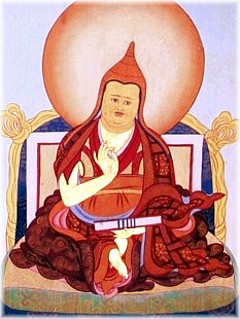
Jamgön Ju Mipham Gyatso, or Mipham Jamyang Namgyal Gyamtso (1846–1912) was a very influential philosopher and polymath of the Nyingma school of Tibetan Buddhism. He wrote over 32 volumes on topics such as painting, poetics, sculpture, alchemy, medicine, logic, philosophy and tantra. Mipham's works are still central to the scholastic curriculum in Nyingma monasteries today. Mipham is also considered one of the leading figures in the Rimé (non-sectarian) movement in Tibet.
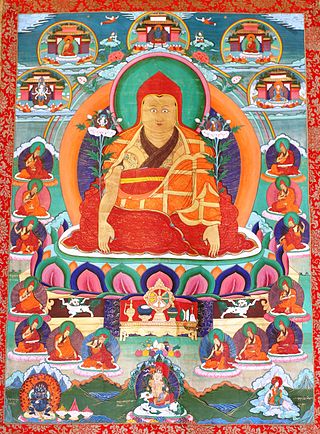
Dölpopa Shérap Gyeltsen (1292–1361), known simply as Dölpopa, was a Tibetan Buddhist master. Known as "The Buddha from Dölpo," a region in modern Nepal, he was the principal exponent of the shentong teachings, and an influential member of the Jonang tradition of Tibetan Buddhism.
Anuyoga is the designation of the second of the three Inner Tantras according to the ninefold division of practice used by the Nyingma school of Tibetan Buddhism. As with the other yanas, Anuyoga represents both a scriptural division as well as a specific emphasis of both view and practice.

Sakya PanditaKunga Gyeltsen was a Tibetan spiritual leader and Buddhist scholar and the fourth of the Five Sakya Forefathers. Künga Gyeltsen is generally known simply as Sakya Pandita, a title given to him in recognition of his scholarly achievements and knowledge of Sanskrit. He is held in the tradition to have been an emanation of Manjusri, the embodiment of the wisdom of all the Buddhas.

Ngor or Ngor Éwam Chöden is the name of a monastery in the Ü-Tsang province of Tibet about 20 kilometres (12 mi) southwest of Shigatse and is the Sakya school's second most important gompa. It is the main temple of the large Ngor school of Vajrayana Buddhism, which represents eighty-five percent of the Sakya school.
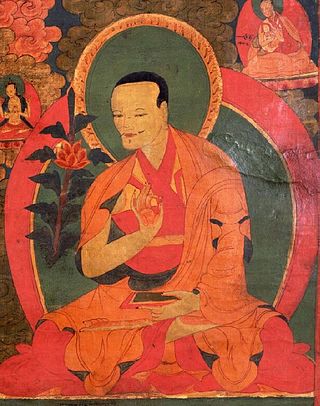
Gorampa Sonam Senge was an important philosopher in the Sakya school of Tibetan Buddhism. He was the author of a vast collection of commentaries on sutra and tantra whose work was influential throughout Tibetan Buddhism. Gorampa is particularly known for his writings on madhyamaka philosophy, especially his critique of the madhyamaka views of Tsongkhapa and Dolpopa. Gorampa defended the mainly anti-realist interpretation of madhyamaka held by the Sakya school.
Lamdré is a meditative system in Tibetan Buddhism rooted in the view that the result of its practice is contained within the path. The name "lamdré" means the “path" with its fruit Wylie: ‘bras). In Tibet, the lamdré teachings are considered the summum bonum of the Sakya school.

Jigdal Dagchen Sakya Rinpoche was a Tibetan Buddhist teacher educated in the Sakya sect. He was educated to be the head of the Sakya school of Tibetan Buddhism as well as the successor to the throne of Sakya, the third most important political position in Tibet in early times. Dagchen Rinpoche was in the twenty-sixth generation of the Sakya-Khön lineage descended from Khön Könchok Gyalpo and was regarded as an embodiment of Manjushri as well as the rebirth of a Sakya Lama from the Ngor sub-school, Ewam Luding Khenchen Gyase Chökyi Nyima.
Ngor is a sub-sect of the Sakya tradition of Tibetan Buddhism. The main monastery of the Ngor sect is the Ngor monastery of Evam Choden about 20 kilometres (12 mi) southwest of Xigazê.
Jetsunma Chime Tenpai Nyima was a Tibetan Buddhist master, the only female master of the Sakya Vajrayoginī lineage. She is also considered a great siddha and an emanation of Vajrayoginī. She was born in Tibet and originally had the name Chime Butri. She was part of the prominent Sakya Khon family, which established itself by the 11th century in Sakya, Tibet. She studied with her uncle Kunga Lodro, who had had a vision prophesying, among other things, that she would be one of the closest disciples who would carry on his teachings. He transmitted to her the core Sakya Lamdre and the Vajrayogini teachings, among others. In 1782, she took novice vows from the twenty-fifth abbot of the Sakya Lhakhang Chenmo, Jampa Chokyi Tashi, who gave her the ordination name by which she has come to be known, Chime Tenpai Nyima.
Jetsun Pema Trinle (1874-1950) was a Tibetan Buddhist teacher, and was one of only a few women authorized to teach the general and esoteric presentation of the Path and Result in the Sakya tradition, known as Lamdre Tsokshe and Lobshe respectively. As a child she received teachings from her paternal great-aunt Jetsunma Tamdrin Wangmo, her elder brother, her father Kunga Nyingpo Sampel Norbu, and the abbot of Ngor, Ngawang Lodro Nyingpo. She rarely gave public teachings. She did tour eastern Tibet to give and receive teachings, and her main teacher there was Tenpai Wangchuk, who himself was a disciple of her great-aunt Tamdrin Wangmo. She also received Lamdre teachings from Jamyang Loter Wangpo, and gave teachings to the 3rd Dezhung Rinpoche.
Shentong is term for a type of Buddhist view on emptiness (śūnyatā), Madhyamaka, and the two truths in Indo-Tibetan Buddhism. It is often contrasted with the term rangtong ("self-emptiness"). The term refers to a range of views held by different Tibetan Buddhist figures.
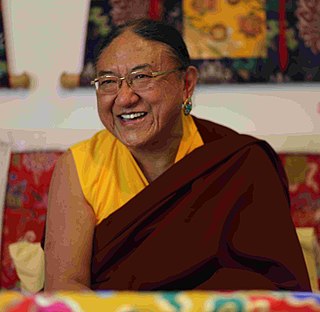
Sakya Trizin Ngawang Kunga served as the 41st Sakya Trizin, the throne holder of the Sakya Lineage of Tibetan Buddhism, from his appointment in 1952 until his retirement in 2017. His religious name is Ngawang Kunga Tegchen Palbar Trinley Samphel Wangyi Gyalpo. After passing the throne of the Sakya lineage to his elder son Ratna Vajra Rinpoche who became the 42nd Sakya Trizin on 9 March 2017, he is now known as Kyabgon Gongma Trichen Rinpoche. He is considered second only to the Dalai Lama, in the spiritual hierarchy of Tibetan Buddhism.
Classes of Tantra in Tibetan Buddhism refers to the categorization of Buddhist tantric scriptures in Indo-Tibetan Buddhism. Tibetan Buddhism inherited numerous tantras and forms of tantric practice from medieval Indian Buddhist Tantra. There were various ways of categorizing these tantras in India. In Tibet, the Sarma schools categorize tantric scriptures into four classes, while the Nyingma (Ancients) school use six classes of tantra.












